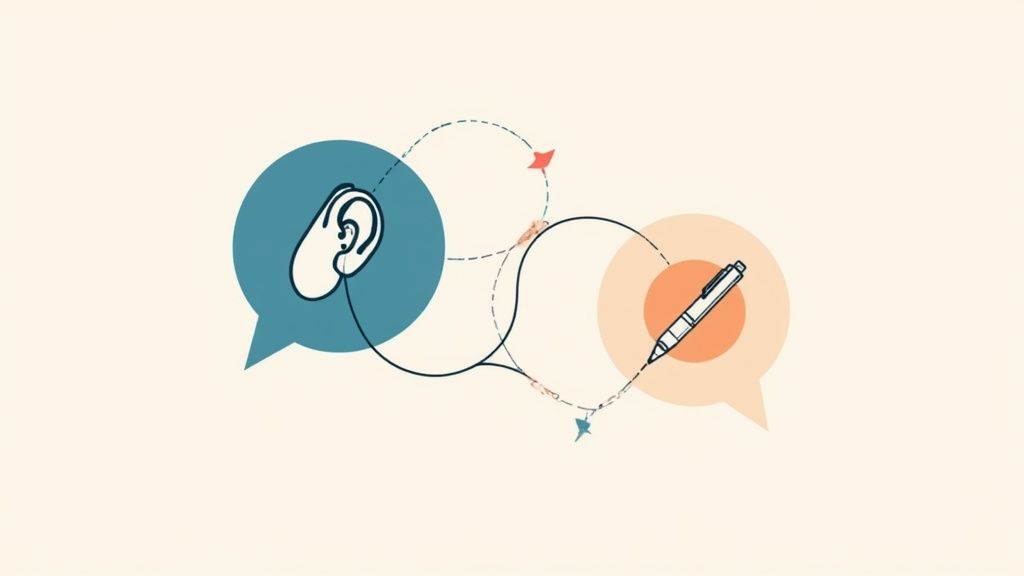9 Web3 Community Engagement Best Practices for 2025

In the fast-paced world of Web3, a strong community isn't just a nice-to-have, it's your project's lifeblood. Hype cycles come and go, but a genuinely engaged group of supporters provides the foundation for sustainable growth, invaluable feedback, and powerful word-of-mouth advocacy. This isn't about chasing vanity metrics; it's about building a resilient ecosystem that can weather market volatility and thrive long-term.
So, how do you move beyond surface-level chatter and build a community that's truly invested? It’s about implementing proven strategies that foster real connection, deliver tangible value, and empower your members to take an active role. Forget generic advice. This guide is your no-nonsense playbook, breaking down the essential community engagement best practices you need to master. We're cutting straight to the actionable techniques that turn passive observers into dedicated contributors and passionate advocates for your project.
You’ll learn how to transform your engagement strategy with practical, step-by-step tips covering everything from authentic communication to data-driven personalization. We'll also show you how to leverage user-friendly, no-code tools like Domino to streamline your efforts, create compelling reward-based quests, and track the activities that truly matter. This isn't just theory; it’s a blueprint for building a community that not only sticks around but actively helps you grow. Get ready to ditch the hype and build a thriving, resilient Web3 ecosystem that lasts.
1. Authentic Two-Way Communication
Forget the old-school megaphone approach where brands just broadcast messages. One of the most critical community engagement best practices is shifting to a genuine, two-way dialogue. This means you're not just talking at your community; you're talking with them. It’s about creating a space where members feel their voices are not only heard but actively sought out and valued.

This isn’t just about having a suggestions channel in your Discord. It's a foundational mindset that prioritizes listening first, responding thoughtfully, and maintaining transparency. When members see their feedback directly influencing project roadmaps or community initiatives, it transforms them from passive followers into active co-creators.
How to Make it Happen
Implementing authentic communication requires a structured, intentional effort. Think of it less as a task and more as a cultural pillar for your community.
- Establish Feedback Loops: Create clear, visible channels for feedback, such as dedicated forums, regular surveys, or even interactive AMAs (Ask Me Anything) with the founding team. Crucially, close the loop by publicly acknowledging the input and showing exactly how it led to a change.
- Train Your Team: Equip your community managers and moderators with active listening skills. This involves more than just answering questions; it means understanding the underlying sentiment, asking clarifying questions, and validating members' perspectives.
- Set Clear Expectations: Be transparent about response times. Let your community know when they can expect an answer, whether it’s within 24 hours for a support ticket or during a weekly roundup for general suggestions.
Pro Tip: Use community management tools like Domino to track conversations and sentiment across platforms. This helps ensure no voice gets lost in the noise and allows you to identify key community advocates and emerging concerns before they escalate.
This approach is powerful because it builds trust, the cornerstone of any strong Web3 community. When members feel respected and influential, their loyalty deepens, leading to higher retention, more organic ambassadorship, and a resilient community that can weather market volatility.
2. User-Generated Content Strategy
Turn your community from passive consumers into active co-creators. A powerful community engagement best practices approach involves building a strategy around user-generated content (UGC). This means empowering your members to create and share content related to your project, transforming them into authentic advocates whose peer-to-peer influence is far more credible than traditional marketing.

Think of it as decentralized marketing. Instead of your team being the sole source of content, you create a framework where memes, tutorials, fan art, and testimonials flourish organically. Campaigns like Starbucks' #RedCupContest or GoPro's customer adventure videos show how this model builds a vibrant, participatory culture while generating a massive library of authentic promotional material.
How to Make it Happen
A successful UGC strategy doesn't happen by accident; it requires clear guidance and meaningful incentives to get the flywheel spinning.
- Establish Clear Guidelines: Create a simple, accessible guide for submissions. Outline content themes, quality standards, and submission channels. Use a branded hashtag (e.g., #MyProjectNFT) to easily track and discover content across platforms like X and Instagram.
- Offer Meaningful Incentives: Recognition is great, but tangible rewards drive participation. Offer prizes like exclusive NFTs, project tokens, special Discord roles, or even a feature in your official newsletter. The key is to make the reward worth the effort.
- Always Credit the Creator: This is non-negotiable. Always ask for permission before reposting and give prominent credit to the original creator. This builds goodwill, respects their work, and encourages others to contribute, knowing they'll be properly acknowledged.
Pro Tip: Use a community platform like Domino to create a dedicated "content-showcase" channel where members can share their creations. You can then use the platform's analytics to identify your most creative and influential contributors, making it easy to build a formal ambassador program around them.
This strategy is incredibly effective because it fosters a profound sense of ownership and belonging. When a member's creation is celebrated by the project, their connection deepens, turning them from a simple user into a passionate evangelist. This creates a self-sustaining content engine that strengthens community bonds and provides a constant stream of genuine social proof.
3. Community-Driven Decision Making
True community engagement goes beyond just listening; it involves actively giving members a seat at the table. One of the most impactful community engagement best practices is to embed community-driven decision-making into your project's DNA. This means moving from a top-down management style to a more democratic model where community members help shape key outcomes and the project's future direction.

This approach transforms members from a passive audience into empowered stakeholders. When people have a say in decisions that affect them, their sense of ownership and commitment deepens dramatically. It's the difference between building for a community and building with a community, a distinction that is especially critical in the decentralized ethos of Web3.
How to Make it Happen
Implementing this requires clear frameworks and a genuine commitment to sharing control. It’s about creating systems, not just one-off polls, to ensure participation is fair, informed, and meaningful.
- Define the Scope: Be upfront about which decisions are on the table. Is the community voting on new features, treasury allocation, or event planning? Clearly defining the boundaries prevents confusion and manages expectations effectively.
- Provide Context and Information: For members to make informed choices, they need access to the same information your core team has. Share relevant data, pros and cons, and potential impacts before any vote or discussion.
- Use Structured Processes: Employ tools like Snapshot for DAO voting, or use structured forum discussions and consensus-building exercises. This ensures the process is transparent and that participation is balanced, preventing the loudest voices from dominating the conversation.
- Show the Impact: Always close the loop by communicating the results and, most importantly, showing how the community's input directly influenced the final outcome. This reinforces the value of their participation and builds momentum for future initiatives.
Pro Tip: Start small. You don't need to form a full-blown DAO overnight. Begin by letting the community decide on smaller, lower-risk items like Discord channel names or the theme for the next content sprint. This builds trust and provides a foundation for more significant decisions later on. Learn more about building this type of engagement from the ground up.
This democratic method is powerful because it directly aligns the project's interests with the community's desires. This alignment fosters incredible loyalty, sparks organic advocacy, and creates a resilient ecosystem where everyone is invested in collective success.
4. Consistent Value Delivery
A community thrives when its members feel they are gaining something worthwhile from being a part of it. This makes consistent value delivery a cornerstone of sustainable growth. It’s about moving beyond initial hype and establishing a predictable rhythm of providing meaningful content, exclusive opportunities, or tangible benefits that align with your members' goals and interests.

This practice is about systematically understanding what your community truly values and then building a program to deliver on that promise reliably. Whether it's educational content like HubSpot Academy’s free courses or exclusive experiences like Sephora's Beauty Insider events, the goal is to make membership an indispensable part of their routine.
How to Make it Happen
Creating a system for consistent value requires a deep understanding of your members and a commitment to serving them proactively. It’s a flywheel that builds momentum over time.
- Create Content Pillars: Define a few core themes that your community cares about and build a content calendar around them. This could include weekly developer workshops, monthly market analysis reports, or exclusive Q&A sessions with industry experts.
- Survey Your Community: Don't guess what members want. Regularly use polls and surveys to ask them directly about their challenges, interests, and what they’d like to see more of. Use this data to refine your value delivery strategy.
- Balance Predictability and Surprise: While consistency is key, occasional "surprise and delight" moments, like an unexpected airdrop or a bonus piece of content, can create memorable experiences and reignite excitement.
Pro Tip: Use a tool like Domino to segment your community based on their engagement and stated interests. This allows you to deliver more personalized value, such as sending advanced technical guides to your developer segment while providing market-level insights to your trader segment.
This approach transforms your community from a simple chatroom into a vital resource hub. When members know they can count on you for regular, high-quality value, their loyalty deepens, and they become more likely to contribute back to the ecosystem.
5. Inclusive and Accessible Design
A thriving community is one where everyone feels welcome and can participate fully. That’s why inclusive and accessible design is a cornerstone of modern community engagement best practices. This isn't just about meeting compliance standards; it’s about intentionally designing your digital spaces, content, and interactions to remove barriers for members with diverse abilities, backgrounds, and circumstances.
This approach ensures that your community is not accidentally excluding valuable members due to poorly designed platforms or communication styles. It’s about building an environment where participation isn't a privilege but a universal right, fostering a deeper sense of belonging and loyalty. When members see a genuine effort to accommodate diverse needs, it signals that the project truly values every single individual.
How to Make it Happen
Integrating inclusivity isn’t a one-off task but an ongoing commitment. It requires a mindset shift that places empathy and user experience at the forefront of every decision, from platform choice to content creation.
- Conduct Accessibility Audits: Regularly review your platforms (website, Discord, forums) using established guidelines like the Web Content Accessibility Guidelines (WCAG). This helps identify and fix issues like poor color contrast, missing alt-text for images, or navigation that isn't keyboard-friendly.
- Include Diverse Voices in Testing: Before launching new features or platforms, involve community members with different abilities and backgrounds in the testing phase. Their direct feedback is invaluable for catching blind spots you might have missed.
- Provide Multiple Formats: Offer information in various ways to cater to different learning and access needs. For example, supplement a video AMA with a written transcript or provide key takeaways from a long-form article in a quick, scannable infographic.
Pro Tip: Train your community managers and moderators on inclusive language and communication practices. This includes simple but powerful habits like adding image descriptions to social media posts, using camelCase for multi-word hashtags (#LikeThisNot #likethis), and avoiding jargon that may alienate newcomers.
This focus on inclusivity is powerful because it expands your potential community base and builds a culture of mutual respect. In the often-intimidating world of Web3, creating a genuinely accessible and welcoming space makes your project a magnet for talent, creativity, and long-term engagement.
6. Data-Driven Personalization
Move beyond a one-size-fits-all approach to engagement by harnessing the power of data. A key component of modern community engagement best practices is using member data and analytics to customize experiences, content, and interactions. This means looking at behavioral insights, stated preferences, and engagement patterns to make every touchpoint feel more relevant and meaningful.
This strategy is about making your community members feel seen as individuals. When you can surface content, events, or even connection suggestions based on their specific interests and activity, you transform their experience from a passive feed into a dynamic, personal journey. It’s the difference between shouting into a crowd and having a focused, one-on-one conversation.
How to Make it Happen
Implementing personalization requires a thoughtful approach to data collection and application. It's less about surveillance and more about service, using insights to add value to the member experience.
- Segment Your Audience: Start by grouping members based on shared characteristics, such as their role in the ecosystem (e.g., developer, investor, user), activity level, or topics of interest. This allows you to tailor communications and initiatives to what each group cares about most.
- Leverage Behavioral Triggers: Set up automated workflows that respond to member actions. For example, if a member frequently engages with content about DAOs, you can automatically send them an invite to an upcoming governance workshop or a relevant discussion channel.
- Offer Preference Controls: Be transparent about how you use data and give members clear control over their personalization settings. Allowing them to opt in or adjust their preferences builds trust and ensures they receive the experience they want.
Pro Tip: Use a community intelligence platform like Domino to consolidate member data from different sources (Discord, Twitter, on-chain activity) into a unified profile. This gives you a 360-degree view to power highly effective, personalized outreach and recognition.
This approach is powerful because it significantly boosts relevance, making members feel understood and valued. When content and opportunities align perfectly with their interests, they are far more likely to engage, contribute, and remain loyal advocates for your project.
7. Crisis Management and Conflict Resolution
Even the most vibrant communities face challenges. A crucial aspect of community engagement best practices is having a proactive framework for handling disputes, controversies, and unexpected crises. It’s not about avoiding conflict entirely, which is impossible, but about managing it constructively to maintain trust and community health.
This goes beyond just banning trolls. It involves developing clear protocols, training your team, and implementing restorative processes to repair harm when incidents occur. A well-handled crisis can actually strengthen community bonds by demonstrating leadership, fairness, and a genuine commitment to member well-being.
How to Make it Happen
Effective crisis management is proactive, not reactive. Building a resilient community means preparing for the worst while hoping for the best.
- Develop Clear Community Guidelines: Create a publicly available, easy-to-understand set of rules and a code of conduct. Outline what is unacceptable behavior and detail the consequences for violations. This document becomes your first line of defense.
- Train Your Team in De-escalation: Don’t assume your moderators instinctively know how to handle a heated situation. Provide training on de-escalation techniques, identifying bad-faith actors, and maintaining a neutral, firm stance during conflicts.
- Establish a Response Protocol: Create a clear, step-by-step plan for different crisis scenarios, like FUD attacks, a security breach, or internal disputes. Define roles, communication chains, and pre-approved messaging to ensure a swift, coordinated response.
Pro Tip: Document every incident and its resolution in a private log. This creates an invaluable knowledge base for training new moderators and refining your crisis protocols over time. It also provides a record to justify actions if a decision is later challenged.
This practice is essential because unchecked conflict can quickly poison a community’s culture, driving away valuable members and eroding trust in the project team. By preparing for difficult situations, you ensure your community remains a safe, productive, and welcoming space even when faced with adversity.
8. Recognition and Reward Systems
Humans are hardwired to appreciate acknowledgment for their efforts. A cornerstone of sustainable community engagement best practices is implementing structured recognition and reward systems that celebrate member contributions. This goes beyond just saying "thanks"; it's about creating a clear framework where positive behaviors, achievements, and valuable input are visibly and consistently rewarded.
This practice operationalizes appreciation, turning passive members into motivated contributors. Think of Stack Overflow's reputation system or the Salesforce Trailblazer Community's points and ranks. These systems provide a clear path for members to gain status and tangible benefits, which in turn reinforces the very actions that make the community valuable for everyone.
How to Make it Happen
Building an effective reward system requires a thoughtful approach that balances intrinsic and extrinsic motivation. It should feel like a natural part of the community culture, not a transactional chore.
- Define Valuable Contributions: Clearly outline what actions you want to encourage. Is it providing helpful answers, creating user-generated content, onboarding new members, or stress-testing a new feature? Be specific so members know exactly what is valued.
- Offer Diverse Rewards: Combine different types of rewards to appeal to a wider audience. This can include digital badges, special roles in Discord, exclusive access to content or events, project tokens, or even physical merchandise.
- Ensure Transparency and Fairness: Make the criteria for earning rewards public and achievable. The system should be perceived as fair and attainable to prevent discouragement. Use a mix of automated tracking for simple metrics (like posts or likes) and human-curated awards for more subjective contributions.
Pro Tip: Your rewards don't always have to be monetary. Often, the most powerful incentives are social status and exclusive access. A unique Discord role or a shout-out from the founding team can be more motivating than a small token airdrop.
A well-designed recognition program acts as a powerful feedback loop. It not only motivates current members but also provides a clear roadmap for new arrivals on how to become valued participants. This fosters a culture of contribution and mutual appreciation, making the community a more engaging and supportive environment. To dive deeper, check out this guide to creating a community incentive program.
9. Multi-Platform Integration
Your community doesn’t live in a single silo, so your engagement strategy shouldn’t either. A crucial component of modern community engagement best practices is multi-platform integration, which creates a cohesive experience across all digital and physical touchpoints. This means whether a member interacts with your brand on Discord, follows you on X (formerly Twitter), or attends an in-person event, the experience feels connected and seamless.
This approach ensures consistent messaging and allows relationships to build and deepen across different environments. Instead of having fragmented communities on each platform, you create a unified ecosystem. Think of how Nike connects its running app, retail stores, and online challenges to build a single, powerful community around fitness.
How to Make it Happen
Building a connected ecosystem requires a deliberate, user-centric strategy that bridges the gaps between your various platforms and channels.
- Map the Member Journey: Start by outlining all the potential touchpoints a member has with your brand. Understand how they move from discovering you on social media to joining your core community platform and participating in events. This map will reveal gaps and opportunities for smoother transitions.
- Use Centralized Management Tools: Employ tools that allow you to manage conversations and post content consistently across multiple platforms from one dashboard. This saves time and ensures your core messaging remains aligned, even when tailoring content for each channel’s unique format.
- Implement Cross-Platform Incentives: Encourage members to connect with you on multiple channels. For example, you could run a giveaway where participants gain extra entries by joining your Discord, following on X, and subscribing to your newsletter. This cross-pollination strengthens the overall community fabric.
Pro Tip: Use a single sign-on (SSO) solution or wallet-based authentication to provide a frictionless experience across your web app, community forum, and other digital properties. The easier it is for members to navigate your ecosystem, the more engaged they will be.
By unifying your presence, you don't just broadcast a message; you build a world for your community to inhabit. This method transforms disparate interactions into a single, continuous conversation, dramatically boosting member loyalty and long-term retention. To dive deeper into this concept, check out this guide to omnichannel community strategies.
Community Engagement Best Practices Comparison
| Item | Implementation Complexity | Resource Requirements | Expected Outcomes | Ideal Use Cases | Key Advantages |
|---|---|---|---|---|---|
| Authentic Two-Way Communication | High | Significant time and personnel | Builds trust, valuable insights, loyalty | Small to mid-sized communities seeking trust | Stronger emotional connections; transparency |
| User-Generated Content Strategy | Medium | Moderate content moderation | Authentic advocacy, reduced content costs | Brands leveraging community creativity | Cost-effective content; diverse perspectives |
| Community-Driven Decision Making | High | Requires facilitation and planning | Increased buy-in and shared ownership | Communities needing democratic participation | Collective wisdom; reduced resistance |
| Consistent Value Delivery | Medium | Consistent content creation | Long-term loyalty and habitual engagement | Communities focused on sustained value delivery | Clear expectations; member retention |
| Inclusive and Accessible Design | High | Ongoing training and development | Expanded reach and improved UX | Diverse communities prioritizing accessibility | Social responsibility; legal risk reduction |
| Data-Driven Personalization | High | Significant technical investment | Higher engagement and personalized experiences | Data-savvy communities aiming for relevancy | Efficient resource use; insights for optimization |
| Crisis Management and Conflict Resolution | Medium to High | Training and preparation | Maintains safety, trust, and conflict control | Communities prone to disputes or emergencies | Prevents escalation; builds confidence |
| Recognition and Reward Systems | Medium | Moderation and reward management | Motivates participation and builds status | Communities focused on member motivation | Increased engagement; social proof |
| Multi-Platform Integration | High | Complex technical integration | Seamless cross-channel engagement | Communities/spaces spanning multiple platforms | Unified experience; broader reach |
Start Building Your Engaged Web3 Community Today
And there you have it: a comprehensive blueprint for transforming your Web3 project from a simple product into a thriving, self-sustaining ecosystem. We've navigated through the essentials, from fostering authentic two-way communication to implementing robust recognition and reward systems. The journey to a deeply engaged community is built on these foundational pillars, but it's crucial to remember that this isn't a checklist you complete once. It's an ongoing, iterative process of listening, adapting, and growing alongside your members.
The core theme weaving through all these community engagement best practices is a shift in mindset. It’s about moving away from a transactional relationship with your users and toward a collaborative partnership. When you empower your members through community-driven decision-making and celebrate their contributions with a solid user-generated content strategy, you're not just building an audience; you're cultivating a legion of advocates who are personally invested in your success. This is the ultimate competitive advantage in the decentralized world.
Your Action Plan for Momentum
Feeling overwhelmed? Don't be. The key is to start small and build momentum. You don't need to implement all nine strategies overnight. Instead, focus on creating immediate impact.
- Pick Your "Easy Win": Review the list and identify one or two practices that resonate most with your project's current stage. Is it formalizing your reward system? Or perhaps improving your crisis management plan?
- Leverage Technology: Don't try to manage everything manually. Tools are designed to handle the heavy lifting. Platforms like Domino can automate the verification of both on-chain and off-chain tasks, freeing you to focus on the human element of community building.
- Listen and Measure: Once you implement a new strategy, pay close attention to the feedback. Use data-driven personalization to understand what resonates, and don't be afraid to pivot based on what your community is telling you.
True engagement is born from consistency and a genuine desire to provide value. It’s about creating a space where members feel seen, heard, and appreciated. Whether you're integrating your presence across multiple platforms or designing more inclusive onboarding flows, every small effort contributes to the bigger picture of a strong, resilient community. If you're looking for more guidance on the initial steps, it's worth exploring the fundamentals of how to build an online community to ensure you start on the right foot.
Ultimately, mastering these community engagement best practices is what separates fleeting projects from lasting legacies in the Web3 space. Your community is your moat, your marketing engine, and your most valuable asset. Nurture it, empower it, and it will become the unstoppable force that propels your vision forward. The time to start is now.
Ready to put these best practices into action without the technical headache? Domino helps you launch powerful, reward-based quests in minutes, automating task verification so you can focus on creativity and connection. Sign up for free today and see how easy it is to supercharge your community engagement.
Level Up Your dApps
Start using Domino in minutes. Use automations created by the others or build your own.
